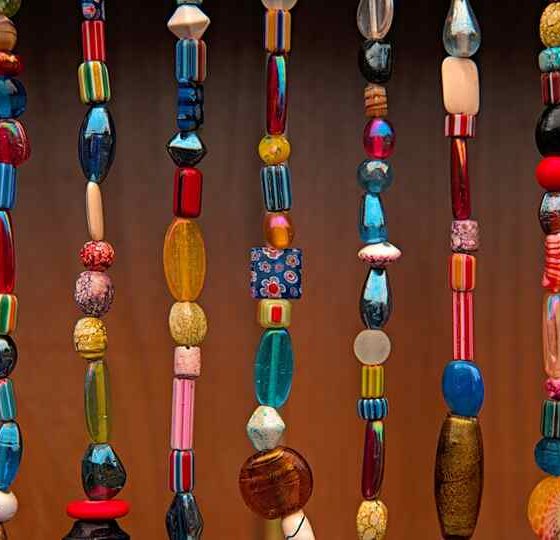Education
The Advantages of a Damascus Blade

Have you ever wondered where the idea of Valyrian steel from Game of Thrones came from? How about the Beskar steel from The Mandalorian?
These mythical metals are all inspired by Damascus steel, a real metal that has earned itself legendary status over thousands of years. Blades forged from this material are sought after, thanks to the distinctive wave-like pattern which covers the surface of the weapon.
But why would anyone buy an expensive blade like this? Read on to find out the advantages that a Damascus blade has over your average knife.
Damascus Blades Are Stronger & Sharper Than Average Blades
If you were to take something like a scalpel or a razor blade and put it under a microscope, you would notice that each looks as if they have teeth. These micro-serrations are responsible for the exceptional sharpness and cutting ability of those blades, and the Damascus blade.
The sharpness associated with micro-serrated blades comes from the fact that the edge which meets the material has small, sharp corners instead of being one even line. This allows the knife to separate the material much faster than with a traditional blade, or even a normal serrated blade.
Layered Metals
Unlike the razor or scalpel, however, a Damascus blade gets its micro-serrations from the materials used during the forging process. These materials are a mix between high-grade carbon steels and regular iron that lay upon one another to create a blade with properties of both ingredients.
Because the edge of the blade comprises alternating layers of different quality steel from top to bottom, as the blade endures use over time the lower quality steel wears away before the high-quality steel. The result of this wearing-away process is those microscopic serrations that give the blade its exceptional sharpness.
This process of alternating layers of high and low-grade carbon is also responsible for the properties of increased strength and durability that Damascus blades have. Specifically, each blade has an inner core of hard, high-quality carbon steel sandwiched between two layers of softer steel.
Best Of Both Worlds
Iron and other softer steels are more flexible and are thus more resistant to chipping, breaking, snapping, or other critical failures which are possible during use. However, this flexibility comes at the expense of hardness. Thus, blade-smiths wrap this material around the blade everywhere except the edge to protect them from damage.
On the other hand, the higher quality steel of the inner core has incredible hardness due to its lack of impurities and forging temperature. This hardness allows the edge to have sharper, cleaner edges. The downside is though, is that harder steel is far more brittle and susceptible to damage. And so, smiths only expose the core on the very edge of the blade.
As you can see, the Damascus blade is essentially the perfect balance of two extremes. Both sharp and strong, hard and resistant. However, these properties only apply to blades forged properly. Cheaper blades forged by those who take shortcuts throughout the process will be no stronger or sharper than your average kitchen knife.
Quality Above All Else
This same principle applies to all blades and any other weapon or tool you can think of. If not forged with the utmost care, respect, and skill, it won’t be worth your time. So if you’re looking to acquire swords knives and daggers, or even a Damascus blade, be sure to visit a reputable smith shop. And prepare to spend a pretty penny for a high-quality piece.
Damascus Blades Have A Legendary History
There are few materials more mythical in nature than Damascus Steel, the material from which Damascus blades get their name. This legendary status is the case because of two reasons: The history of the material is long and highly contested amongst scholars, and the ancient process people used to make the material became lost to time.
The most widely accepted theory about the origins of Damascus blades is that it came from material in ancient India called Wootz steel that had increased properties of hardness and toughness due to the various small alloys inside the metal being exceptionally hard materials such as tungsten, chromium, and vanadium.
This Wootz steel was then shipped from India across the ancient trading networks and eventually made its way to a city in then Syria called Damascus. The blacksmiths in Damascus were among the best in the world at the time, and they used their skill with the hammer to forge weapons out of a mixture of Wootz steel and lower quality iron.
Superior Weapons, Superior Army
Compared to conventional iron or bronze weapons which were widely used during the time, Damascus blades were far superior. It is for this reason that many military figures and armies have carried, owned, and fought with Damascus blades. Even Alexander the Great carried a Damascus sword on his hip.
The vast military superiority of Damascus blades over most weapons in the ancient world is also a reason why the process of making the blades is unknown. Those who knew how to make the weapons held the information close to the chest to prevent rival military forces from getting their hands on the technology.
But this secrecy would be the downfall of the original ancient Damascus Steel. By the 1700s, no one knew how to create the material anymore. In most cases, people did not write the recipe down. Instead, they passed it down orally or through the master-apprentice dynamic. And the few places where it might have existed in written had not survived the test of time.
A New Challenger Appears
Adding to that, new technologies would arise during the early modern period that challenged or even outmatched the superiority of Damascus blades. Modern metallurgy technology and techniques made high-quality steel weapons on par with Damascus commonplace, and the introduction of firearms would eventually make all such weapons obsolete.
Despite this, Damascus weaponry has survived to the present day thanks to the discovery of a process similar to that of the ancients in terms of the final product. Although not the same, our Modern Damascus steel is close enough that they inherited the legendary history of the original.
Damascus Blades Are Beautiful & Timeless
What most people think of when they imagine Damascus blades is the beautiful wave-like ripple pattern that covers the blade from tip to heel. These Damascus Steel patterns are responsible for the blade earning the name ‘watered blade’, and for people mistaking other blades with similar patterns as Damascus, despite having differing origins.
There are two known processes for authentically creating the ripple pattern of Damascus Steel and one process which creates only a superficial pattern that resembles true forged Damascus. Each process has benefits and drawbacks associated with it, so it’s important to know which forged your blade before purchasing.
Pattern-Welding
The first process, and the one used to construct all Modern Damascus blades, is pattern welding. This process creates the characteristic watery effect throughout the entire blade, from the surface through to the bottom. It also gives the blade many of the same properties that the ancient process would have.
Essentially, pattern-welding is the same layering of different quality metals discussed earlier in this article. High-quality steel and low-quality iron fuse together by folding and hammering at high temperatures until a welded bond forms. After enough iterations, the wavy effect arises due to the color difference between the two materials.
Cast Damascus
The second process is Cast Damascus. While the true, original cast Damascus process has been completely lost to time, modern metallurgists have come up with an approximation that comes close to what the ancient method would have been. But since the original materials have also been completely lost, no blade forged from this process exists today.
After combining iron, steel, and charcoal into a large blast furnace sealed off from oxygen, smiths supply enough heat to melt everything together. There, carbon atoms from the charcoal find their way into the metal, and after cooling form a crystal-like structure in the material. Forging the resulting ingot would then produce the ancient Damascus blades, complete with the watery pattern they get their beauty from.
While the former two processes create authentic Damascus blades with a pattern that runs through the metal, acid or laser etching does not. This process only etches the watery pattern into the surface of an otherwise normal steel blade. Thus, after enough use, the pattern will wear away completely. So even though they are cheap, buying Damascus blades produced this way is a waste of time.
Proper Care
It is also a waste to buy an expensive, authentic Damascus blade only to not take care of it. If not cared for, these blades will rust, dull, and lose their beautiful pattern. Ensure that you care for them by washing and drying them after use with a non-abrasive material and applying a coat of wax to keep away moisture.
Think Damascus Blades Are Cool? Take A Look At This…
Damascus blades aren’t the only cool items you can read about on this website. Our other articles showcase many more interesting novelties which would fit right in with your new legendary blade. So keep browsing around our site and find out about more epic products today.
Education
Applying to an English course in Birmingham: Tips and Advice


Are you considering studying English courses in Birmingham?
If so, you’re about to begin an exciting journey in language learning and cultural exposure. To ensure that your application process is smooth and successful, here are some valuable tips and advice to guide you through.
1. Research Your Options
Before you begin your application, the obvious step is to investigate your selections among the best English courses in Birmingham.
Investigate other institutions, their courses, teaching techniques, and student feedback. Consider the class size, course duration, and specialist areas of study in the English language programme.
To learn more about English courses in Birmingham, visit the websites of local universities and language schools.
- Compare course curriculums, costs, and other support services offered.
- Ask current or previous students about their experiences.
2. Understand the Application Requirements
Each English course in Birmingham may have different application requirements. Criteria such as language proficiency tests, academic credentials, recommendation letters, or personal statements.
Before submitting your application, be sure you understand the prerequisites and meet all of the admission criteria.
Tips for Meeting Application Requirements.
- Take language competence tests, such as IELTS or TOEFL, if necessary. (Typically, students from non-English backgrounds/nations must take an English language competence test to be admitted.)
- Contact teachers and mentors ahead of time to request recommendation letters.
- Write a convincing personal statement of purpose essay highlighting your passion and motivation for studying English at Birmingham.
3. Submit a Well-Crafted Application
When drafting your application, pay close attention to detail and make sure it represents your real interest in studying English. To increase your chances of admission, submit all needed documentation on time and precisely.
Strong application components include:
A strong application should include a clear and concise personal statement that reflects motivation and ambitions.
• Provide official transcripts and certifications to demonstrate your academic history.
• Provide thoughtful recommendation letters that reflect your skills and abilities.
• Check all documents for grammar and spelling mistakes before submitting.
4. Seek Scholarships and Financial Aid
Studying abroad can be costly at times, but don’t let that stop you from pursuing your aspirations.
Look at scholarship, grant, and financial aid options for international students applying to English classes in Birmingham.
International students can find funding opportunities through scholarships granted by universities, government agencies, and private institutions.
- Inquire about work-study or part-time career opportunities in Birmingham.
- Consider alternate money sources such as savings, loans, or crowdsourcing platforms.
5. Stay Positive and Persistent
The application process for an English course in Birmingham may be competitive, but don’t let that discourage you. Stay positive, be patient, and remain persistent throughout the application timeline. Remember that each step brings you closer to achieving your academic goals.
In conclusion, applying to English courses in Birmingham can be a rich experience that opens doors to new career opportunities and personal growth.
By following these tips and advice, you can navigate the application process with confidence and set yourself up for success in your academic journey. Consider enrolling today to get your journey started!
Education
High School Internships: Building Blocks for Your Future


Internships for high school are more than a mere tick on a resume. Today, they lay the foundational blocks toward a more considered and well-planned future. Navigating school years is a formidable challenge for students. However, the journey can be enriched with valuable lessons and skills acquired through internships.
Real-world Exposure:
- Internships provide high school students with a taste of working life outside the academic bubble. They offer an escape from textbooks and classrooms, presenting potential career paths to explore. This real-world exposure is invaluable for students trying to identify their early interests and passions.
Skill Development:
- Beyond textbook learning, internships offer practical application of skills. From communication and problem-solving to technical abilities, students gain hands-on experience that extends beyond traditional educational boundaries.
College Admissions Advantage:
- In the competitive race for college admissions, internships can be a significant advantage. They demonstrate to admissions officers a proactive, action-oriented approach to learning and success.
Start Early:
- Starting internships early can lead to greater success. While some programs are tailored specifically for high school students, providing a structured introduction to the working world, others span various fields like business and bio-medicine. This early exposure smooths out the transition from academic concepts to career realities.
Leverage Networking:
- Networking is crucial in career building. Internships offer high school students opportunities to connect with professionals in their field of interest. These connections can provide mentorship and valuable insights for future career endeavors.
Tailor Internships to Career Goals:
- It’s important for students to seek internships aligned with their career goals. Whether in STEM, arts, or business, targeted internships offer more focused and relevant experiences. Colleges look beyond academic scores, valuing the ability to apply theoretical knowledge in practical settings. High school internships provide a tangible demonstration of a student’s active engagement in learning and development.
Standout Applications:
- Internships enhance college applications by showcasing practical skills acquired outside the standard curriculum. These experiences make applicants stand out to admissions officers.
Demonstrating Initiative:
- Internships reflect a student’s capacity to tackle challenges and take initiative. This quality is highly valued in the college admissions process, indicating an active and dynamic approach to learning and personal development.
Insight into Chosen Field:
- For students with clear career objectives, internships provide hands-on experience in their chosen field. This direct exposure aids in making informed decisions about college courses and future professions.
Finding the Right Internship: Advice from College Admissions Experts
Embarking on a high school internship journey involves selecting the right opportunity, navigating the first day, and adapting to different professional environments.
Research Opportunities:
- Students should thoroughly research internship opportunities. Many organizations offer programs specifically designed for high school students, providing a more structured experience than self-directed options.
Seek Guidance:
- Consulting with knowledgeable counselors, such as those from IVY’D, who have experience and insights into specific internship programs, is beneficial. Their team of Ivy League graduates and admissions advisors can guide students towards internships that align with their academic, personal, and professional goals.
Leverage Resources:
- IVY’D focuses on empowering communities and individuals. They offer free college preparation workshops for nonprofits, libraries, and schools, providing students with the guidance needed to pursue higher education.
Conclusion:
Internships for high school are not just about ticking a box; they represent an investment in personal and professional growth. These experiences lay the groundwork for success in education and beyond, helping young individuals find their passion and interests. The high school internship process grants invaluable experiences, develops coping skills, and provides insightful perspectives, setting students on a path to a brighter, more informed scholarly and professional future.
Education
Decoding 2024’s Hydration Trends: Alkaline Water Vs. Hydrogen Water


In a world where health and wellness are increasingly becoming top priorities, staying hydrated has never been more critical. We’ve come a long way from simply quenching our thirst with tap water or the occasional bottled water. Today, the hydration market is flooded with various options, each claiming to offer unique benefits. Among the emerging trends in the realm of hydration, two stand out: Alkaline water and Hydrogen water.
Alkaline Water: The Basics
The pH level of alkaline water is higher than that of normal tap water. It is usually between 8 and 9 on the pH scale. Some ways to get this high pH are through ionization or adding alkaline minerals like magnesium, calcium, and potassium.
The Science Behind Alkaline Water
Proponents of alkaline water argue that it can help balance the body’s pH level, which tends to be slightly acidic. They believe that by drinking alkaline water, you can reduce the acidity in your body, potentially preventing various health issues.
Our body’s pH level is tightly regulated, and deviations from the norm can be detrimental to health. However, the body has a robust buffering system that helps maintain a stable pH within a narrow range. Skeptics argue that drinking alkaline water has minimal impact on the body’s pH, as the stomach is highly acidic to aid in digestion. When you consume alkaline water, it passes through the stomach, where the acidic environment quickly neutralizes it, making its effects on overall body pH limited.
Purported Benefits of Alkaline Water
Hydration: Because its molecules are less clumped together, alkaline water is thought to be easier for the body to absorb. But there isn’t a lot of solid evidence to back up this claim.
Antioxidant Properties: Some alkaline water enthusiasts claim that it possesses antioxidant properties due to its negative oxidation-reduction potential (ORP). Free radicals and oxidative stress can be fought with antioxidants, which may lower the chance of getting chronic illnesses.
Better Bone Health: Calcium and magnesium are chemicals that are important for bone health that are found in alkaline water. Some people say that drinking alkaline water can help keep bones from breaking.
Improved Digestion: Some people believe that alkaline water can help digestion by eliminating too much stomach acid and easing the signs of acid reflux.
Hydrogen Water: The Basics
Hydrogen-rich water, which is another name for hydrogen water, is water that has molecular hydrogen (H2) gas added to it. Molecular hydrogen is a gas that has no color or smell and has gotten a lot of attention because it might be good for your health.
The Science Behind Hydrogen Water
The concept behind hydrogen water is based on the idea that molecular hydrogen acts as a powerful antioxidant. It is believed to have the ability to neutralize harmful free radicals, reducing oxidative stress and inflammation in the body.
Hydrogen’s small molecular size allows it to penetrate cell membranes and enter the cellular compartments, where it may have a therapeutic effect. It’s thought to selectively target the most harmful free radicals, such as hydroxyl radicals, without interfering with essential signaling molecules in the body.
Purported Benefits of Hydrogen Water
Antioxidant Properties: Hydrogen water is praised for its potential to combat oxidative stress, which is implicated in various chronic diseases, including cancer, diabetes, and neurodegenerative disorders.
Improved Athletic Performance: Some studies suggest that hydrogen water may enhance physical performance by reducing muscle fatigue and promoting faster recovery.
Brain Health: Because hydrogen can pass through the blood-brain barrier, some people think it may have neuroprotective benefits that lower the chance of cognitive loss and neurodegenerative illnesses.
Skin Health: Hydrogen water is claimed to have benefits for skin health, with proponents suggesting it can reduce wrinkles, improve skin hydration, and promote a more youthful appearance.
The Debate: Alkaline Water vs. Hydrogen Water
As we’ve looked into the science and supposed benefits of both alkaline water and hydrogen water, it’s important to note that scientists are still arguing about how well they work.
Alkaline Water Debate
Critics of alkaline water argue that the body’s pH regulation is a highly complex and tightly controlled process. The body maintains a slightly acidic pH in the stomach to aid digestion, while the blood and other tissues have a stable pH range. Drinking alkaline water may have limited impact on these systems, as the body compensates for any pH fluctuations.
Furthermore, the scientific evidence supporting the health benefits of alkaline water is limited and often inconclusive. While some studies suggest potential benefits, many are small in scale, and more robust research is needed to draw definitive conclusions.
Hydrogen Water Debate
On the other hand, the best hydrogen water machine has garnered more interest from the scientific community due to its potential antioxidant properties. Several studies have explored the effects of hydrogen-rich water on various health markers, and while the results are promising, more research is needed to establish its effectiveness definitively.
One challenge in the hydrogen water debate is determining the optimal concentration of hydrogen for therapeutic effects. Too much hydrogen may have limited benefits, while too little may not yield any noticeable effects.
Considerations for Making a Choice
When considering whether to incorporate alkaline water or hydrogen water into your hydration routine, several factors should guide your decision:
Personal Health Goals: Assess your specific health needs and goals. If you are primarily concerned with reducing oxidative stress, hydrogen water may be more aligned with your objectives.
Taste and Preference: Some people prefer the taste of alkaline water over regular tap water, which may encourage increased hydration. Hydrogen water typically has no distinct taste.
Scientific Evidence: Keep in mind that both alkaline water and hydrogen water have limited conclusive scientific evidence supporting their benefits. Therefore, it’s essential to approach these options with a degree of skepticism.
Cost and Accessibility: Consider the cost and accessibility of these products in your area. Alkaline water may be more readily available, while hydrogen water may require specialized equipment or hydrogen tablets.
Consult a Healthcare Professional: A healthcare expert or nutritionist can give you personalized advice based on your health state and goals before you make any big changes to how you stay hydrated.
The Bottom Line
As of 2024, more specific ways to stay hydrated, such as alkaline water and hydrogen water, are becoming popular. Although these drinks seem like they might be good for you, it’s important to look at them with a critical eye and think about your own health goals and wants. It’s important to remember that healthy food and way of life are still the best ways to stay healthy generally. Staying hydrated is essential, but the choice between alkaline water and hydrogen water should be made with care and awareness of the available scientific evidence. Ultimately, the best hydration choice for you may be the one that aligns with your preferences and complements your overall health and wellness strategy.
-



 Biography6 years ago
Biography6 years agoJacqulyn Elizabeth Hanley is the Mother of Liza Soberano?
-



 Home5 years ago
Home5 years agoEpson L3110 Driver Free Download Latest Updated Version
-



 Games4 years ago
Games4 years agoBest Free To Play MMORPG To Try This 2021
-



 Biography6 years ago
Biography6 years agoAmanda Levy Mckeehan Biography, Family, Net Worth, Age, Affairs, Facts
-



 Biography6 years ago
Biography6 years agoWho is Rose Dorothy Dauriac? Scarlett Johansson Daughter?
-



 Biography6 years ago
Biography6 years agoJessica Ditzel Secret Information that Nobody Knows | Joe Rogan’s Wife
-



 Biography6 years ago
Biography6 years agoWhat is the relation of Nathaniel Larry Osorno with Liza Soberano?
-



 Home6 years ago
Home6 years agoLiza Soberano Biography, Age, Family and Boyfriends































